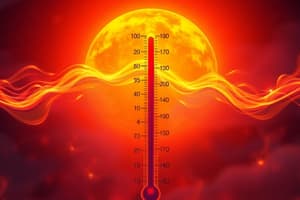Podcast
Questions and Answers
What is the process by which heat is transferred between objects that are touching each other?
What is the process by which heat is transferred between objects that are touching each other?
- Radiation
- Diffusion
- Conduction (correct)
- Convection
Which temperature scale uses absolute zero as its starting point?
Which temperature scale uses absolute zero as its starting point?
- Rankine
- Celsius
- Kelvin (correct)
- Fahrenheit
What physical state is primarily responsible for convection?
What physical state is primarily responsible for convection?
- Both B and C (correct)
- Liquid
- Solid
- Gas
Which of the following is an example of convection?
Which of the following is an example of convection?
What is the value of 25°C in Kelvin?
What is the value of 25°C in Kelvin?
What is the primary method of heat transfer when warm fluid rises and cool fluid descends?
What is the primary method of heat transfer when warm fluid rises and cool fluid descends?
When transferring heat internally within a solid, which method of heat transfer is primarily in effect?
When transferring heat internally within a solid, which method of heat transfer is primarily in effect?
What is heat transfer through electromagnetic waves called?
What is heat transfer through electromagnetic waves called?
What type of element is used in resistive temperature devices?
What type of element is used in resistive temperature devices?
Which material is commonly used to house resistive temperature devices?
Which material is commonly used to house resistive temperature devices?
What is a key characteristic of thermistors?
What is a key characteristic of thermistors?
What is a drawback of using thermistors?
What is a drawback of using thermistors?
Why might thermistors be considered low cost?
Why might thermistors be considered low cost?
What is a limitation of the temperature range for thermistors?
What is a limitation of the temperature range for thermistors?
Which factor is important when selecting a temperature sensor?
Which factor is important when selecting a temperature sensor?
Which of the following is NOT a feature of thermistors?
Which of the following is NOT a feature of thermistors?
What materials typically compose a thermistor?
What materials typically compose a thermistor?
Which term refers to thermistors that increase resistance as temperature increases?
Which term refers to thermistors that increase resistance as temperature increases?
How does a thermistor with a Negative Temperature Coefficient (NTC) behave as temperature decreases?
How does a thermistor with a Negative Temperature Coefficient (NTC) behave as temperature decreases?
What type of device uses a metal sensing element that changes resistance in response to temperature?
What type of device uses a metal sensing element that changes resistance in response to temperature?
What is a common feature of thermistors regarding their construction?
What is a common feature of thermistors regarding their construction?
Which application would likely utilize a Positive Temperature Coefficient (PTC) thermistor?
Which application would likely utilize a Positive Temperature Coefficient (PTC) thermistor?
What kind of electrical response do thermistors exhibit when temperature changes?
What kind of electrical response do thermistors exhibit when temperature changes?
Which of the following statements about thermistors is FALSE?
Which of the following statements about thermistors is FALSE?
What is a major disadvantage of thermistors compared to RTDs and thermocouples?
What is a major disadvantage of thermistors compared to RTDs and thermocouples?
Which of the following statements is true regarding Resistance Temperature Detectors (RTDs)?
Which of the following statements is true regarding Resistance Temperature Detectors (RTDs)?
Which characteristic of RTDs contributes to their reliability over time?
Which characteristic of RTDs contributes to their reliability over time?
What is one of the primary drawbacks of using thermistors in temperature sensing applications?
What is one of the primary drawbacks of using thermistors in temperature sensing applications?
What practical advantage do RTDs offer in terms of output compared to thermocouples?
What practical advantage do RTDs offer in terms of output compared to thermocouples?
What is a limitation of using thermistors regarding system reliability?
What is a limitation of using thermistors regarding system reliability?
Which statement accurately reflects the durability of RTDs?
Which statement accurately reflects the durability of RTDs?
What is one of the advantages of using RTDs over thermistors?
What is one of the advantages of using RTDs over thermistors?
How do the resistance changes of thermistors compare to RTDs?
How do the resistance changes of thermistors compare to RTDs?
Which disadvantage is commonly associated with thermistors?
Which disadvantage is commonly associated with thermistors?
Which of the following characteristics is an advantage of bi-metal thermostats?
Which of the following characteristics is an advantage of bi-metal thermostats?
What is a notable disadvantage of bulb and capillary thermostats?
What is a notable disadvantage of bulb and capillary thermostats?
Which statement accurately describes silicon sensors?
Which statement accurately describes silicon sensors?
What is an advantage of infrared (IR) pyrometry?
What is an advantage of infrared (IR) pyrometry?
Which disadvantage of thermoelectric sensors is significant?
Which disadvantage of thermoelectric sensors is significant?
In what way are thermistors advantageous as temperature sensors?
In what way are thermistors advantageous as temperature sensors?
What is a primary benefit of using thermocouples?
What is a primary benefit of using thermocouples?
What limitation do silicon sensors have compared to RTDs?
What limitation do silicon sensors have compared to RTDs?
Which factor can significantly affect the accuracy of infrared (IR) sensors?
Which factor can significantly affect the accuracy of infrared (IR) sensors?
What is the major drawback of using thermistors as a temperature sensor?
What is the major drawback of using thermistors as a temperature sensor?
Which of the following is a disadvantage of bi-metal thermostats?
Which of the following is a disadvantage of bi-metal thermostats?
Which of these sensors is best suited for high temperature applications?
Which of these sensors is best suited for high temperature applications?
Why might a user choose thermistors over other types of sensors?
Why might a user choose thermistors over other types of sensors?
When considering a sensor, which factor is least likely to influence its selection?
When considering a sensor, which factor is least likely to influence its selection?
Flashcards are hidden until you start studying
Study Notes
Temperature Scales
- Celsius (°C) is a common temperature scale.
- Fahrenheit (°F) is another common temperature scale.
- Kelvin (K) is the absolute temperature scale, 0K is absolute zero.
- Rankine (°R) is another absolute temperature scale, often used in engineering.
Heat Transfer
- Conduction is the transfer of heat between objects in contact.
- Convection is the transfer of heat by moving fluids.
Thermistors
- Thermistors are devices that change electrical resistance with temperature.
- A Positive Temperature Coefficient (PTC) thermistor's resistance increases with temperature.
- A Negative Temperature Coefficient (NTC) thermistor's resistance decreases with temperature.
Resistive Temperature Devices
- The sensing element in resistive temperature devices is an electrical resistor.
- Resistance changes with temperature.
Selecting Temperature Sensors
- Thermistors are highly sensitive, have a wide range of applications, are inexpensive, but are nonlinear and have a limited temperature range.
- Consider these factors when selecting a temperature sensor:
- How tightly must temperature be controlled?
- How important is the total system cost?
Electro-Mechanical Bi-Metal Thermostats
- Advantages:
- Direct interface with applications for fast response.
- No additional circuitry or components required.
- Available in hermetic and non-hermetically sealed designs.
- High current carrying capabilities.
- Wide operating temperature range.
- Market-based pricing.
- NASA qualified, high reliability and military versions are available.
- Disadvantages:
- Less accurate than most electronic-based systems.
- Larger size than electronic-based systems.
- Cannot interface with electronic components.
- May experience "closed" failure at the end of life.
Electro-Mechanical Bulb and Capillary Thermostats
- Advantages:
- Control can be located a significant distance from the sensing application.
- Built-in overtemperature systems available.
- Broad operating temperature range.
- High current carrying capability.
- Disadvantages:
- Large size.
- Relatively expensive.
- Limited number of potential applications.
Electronic Silicon Sensors
- Advantages:
- Less expensive than RTDs.
- More linear than thermistors.
- Easier to use than RTDs or thermocouples due to higher output.
- IC types offer on-chip signal conditioning.
- Many IC types have communication protocols with bus-type data acquisition systems.
- Disadvantages:
- Not as linear as RTDs.
- Less accurate than other electronic-based systems.
- More expensive than thermistors or thermocouples.
- Limited temperature range.
- Slower thermal response than other electronic-based systems.
- Typically larger than RTDs and thermistors.
- Require larger package sizes for immersion.
- Additional components/circuitry required to control application loads.
Electronic Infrared (IR) Pyrometry
- Advantages:
- Allows for non-contact measurement of moving objects or hazardous materials.
- Can be used with fiber optics for remote sensing.
- Typical temperature range of -18°C to +538°C (0°F to 1000°F).
- Accuracy to ±1%.
- Disadvantages:
- Accuracy can be affected by surface finish.
- Field of view must be matched to the target size.
- Ambient temperature can affect readings.
- Wavelength filter must be matched to the application.
- Higher cost can be even higher if control circuitry is required.
- Calibration can be difficult and costly.
- Additional components/circuitry required to control application loads.
- Dust, gas, or other vapors in the environment can affect accuracy.
Electronic Thermocouples
- Advantages:
- Small size for rapid temperature response.
- Relatively inexpensive.
- Wide temperature range.
- More durable than RTDs in high-vibration and high-shock applications.
- ANSI established calibration types.
- Disadvantages:
- Must be protected from corrosive environments.
- Smaller gage wires are less stable and have a shorter operating life.
- Plated-copper instrumentation wire results in errors when ambient temperatures change.
- Special extension wires are required.
- Reference junction compensation is required.
- Less stable than RTDs in moderate or high temperatures.
- Should be tested to verify performance under controlled conditions for critical applications.
- Additional components/circuitry required to control application loads.
Resistive Thermistors
- Advantages:
- Low component cost.
- Fast thermal response.
- Large change in resistance vs. temperature for more resolution.
- Extremely small size, providing faster reaction to change in temperature and flexibility in assembly.
- Linearized resistance types are available.
- High resistance values eliminate the need for lead wire compensation.
- Disadvantages:
- Limited temperature range.
- Lower temperature exposures than RTDs or thermocouples.
- No established resistance standards.
- Self-heating can affect accuracy.
- Nonlinear resistance change requires additional components for accurate interpretation.
- Increased component count decreases system reliability.
- Additional components/circuitry required to control application loads.
Resistive Resistance Temperature Detectors (RTDs)
- Advantages:
- Very accurate and repeatable.
- Wide temperature range of -200°C to +650°C (-328°F to +1202°F) depending on type.
- Extremely stable over time: >0.1°C/year drift.
- Larger voltage output than thermocouples.
- Excellent resistance linearity.
- Resistance can be determined in the lab and remains stable over time.
- Area or point sensing capabilities available.
- Low variation for better interchangeability.
- Standard instrumentation cable can be used to connect to control equipment.
- Established industry-accepted resistance curves.
- Disadvantages:
- Higher cost than thermistors or thermocouples.
- Self-heating of the RTD affects overall system accuracy.
- Larger size than thermistors or thermocouples.
- Not as durable as thermocouples in high-vibration and high-shock environments.
Studying That Suits You
Use AI to generate personalized quizzes and flashcards to suit your learning preferences.




